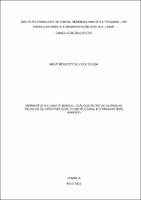Use este identificador para citar ou linkar para este item:
https://repositorio.idp.edu.br//handle/123456789/3597| Título: | Hermenêutica constitucional: diálogo entre as clássicas técnicas de interpretação constitucional e o pragmatismo jurídico |
| Autor(es): | Sousa, Hélio Roberto Silva de |
| Orientador(es): | Branco, Paulo Gustavo Gonet |
| Palavras-chave: | Hermenêutica constitucional;Clássicas técnicas de interpretação constitucional;Pragmatismo jurídico |
| Data de submissão: | 2021 |
| Editor: | IDP/EAB |
| Citação: | SOUSA, Hélio Roberto Silva de. Hermenêutica constitucional: diálogo entre as clássicas técnicas de interpretação constitucional e o pragmatismo jurídico. 2021. 83 f. Trabalho de Conclusão de Curso (Graduação em Direito) - Instituto Brasileiro de Ensino, Desenvolvimento e Pesquisa, Brasília, 2022. |
| Resumo: | O trabalho em comento buscou apresentar uma reflexão sobre a importância do
processo hermenêutico para interpretação constitucional. Para tanto, discorremos,
inicialmente (primeiro capítulo), sobre a importância da interpretação, sob a ótica da
segurança jurídica e da concretude do direito àqueles destinatários desse processo
interpretativo.
No segundo capítulo, mergulhamos em aspectos multifacetários da interpretação.
Focamos, então, no papel do intérprete diante do processo interpretativo. Em seguida,
discorremos sobre o desenvolvimento do conceito de círculo hermenêutico e a novel
leitura da espiral hermenêutica. Seguimos o capítulo analisando as idiossincrasias
inerentes às regras e aos princípios, finalizando este subtópico com a importante
discussão relacionada à superabilidade, defeasibility ou derrotabilidade das regras.
Ato contínuo, analisamos os aspectos relacionados à dicotomia mens legislatoris x
mens legis. Então, para finalizar este capítulo, ancorados em Peter Häberle,
discorremos sobre se a legitimidade do intérprete autêntico (juiz) é exclusiva.
No terceiro capítulo, apresentamos as clássicas técnicas de interpretação
constitucional, nomeadamente o método hermenêutico-clássico, composto pelos
cânones de interpretação gramatical, lógico, sistemático, histórico e teleológico, além
do método tópico-problemático e hermenêutico-concretizador.
Passando para o capítulo seguinte, discorremos sobre os fundamentos do
Pragmatismo Jurídico, apontando as balizas fincadas por Richard Posner, notório
ícone moderno dessa metodologia de aplicação do direito.
Quanto ao último capítulo, precedemos à análise do Habeas Corpus 124.306/RJ. Após
a exposição dos argumentos apresentados no voto vencedor, aplicamos método que
analisa a estrutura argumentativa de decisões judiciais, desenvolvido por Manuel
Atienza. Em seguida, realizamos prognóstico teórico sobre qual teria sido o resultado
do julgado se se tivessem aplicado as clássicas técnicas de interpretação
constitucional. |
| Abstract: | The work in question sought to present a reflection on the importance of the hermeneutic process for constitutional interpretation. To do so, we discussed, initially (first chapter), about the importance of interpretation, from the perspective of legal certainty and the concreteness of the right to those addressed by this interpretative process. In the second chapter, we delve into multifaceted aspects of interpretation. We then focus on the role of the interpreter in the face of the interpretive process. Then, we discuss the development of the concept of the hermeneutic circle and the novel reading of the hermeneutic spiral. We followed the chapter by analyzing the idiosyncrasies inherent in the rules and principles, ending this subtopic with the important discussion related to the superability, defeasibility or defeatability of the rules. On a continuous basis, we analyzed the aspects related to the dichotomy mens legislatoris x mens legis. So, to conclude this chapter, anchored in Peter Häberle, we discuss whether the legitimacy of the authentic interpreter (judge) is exclusive. In the third chapter, we present the classic techniques of constitutional interpretation, namely the hermeneutic-classical method, composed of the canons of grammatical, logical, systematic, historical and teleological interpretation, in addition to the topicalproblematic and hermeneutic-concretizing method. Moving on to the next chapter, we discuss the fundamentals of Legal Pragmatism, pointing out the goals set by Richard Posner, a notorious modern icon of this methodology for the application of law. As for the last chapter, we preceded the analysis of Habeas Corpus 124.306/RJ. After exposing the arguments presented in the winning vote, we applied a method that analyzes the argumentative structure of judicial decisions, developed by Manuel Atienza. Then, we made a theoretical prognosis on what the outcome of the trial would have been had the classic techniques of constitutional interpretation been applied. |
| URI: | https://repositorio.idp.edu.br//handle/123456789/3597 |
| Aparece nas coleções: | Trabalhos de Conclusão de Curso (Graduação) |
Arquivos associados a este item:
| Arquivo | Descrição | Tamanho | Formato | |
|---|---|---|---|---|
| TCC_ HÉLIO ROBERTO SILVA DE SOUSA _2020.pdf | 972.23 kB | Adobe PDF |  Visualizar/Abrir |
Os itens no repositório estão protegidos por copyright, com todos os direitos reservados, salvo quando é indicado o contrário.
